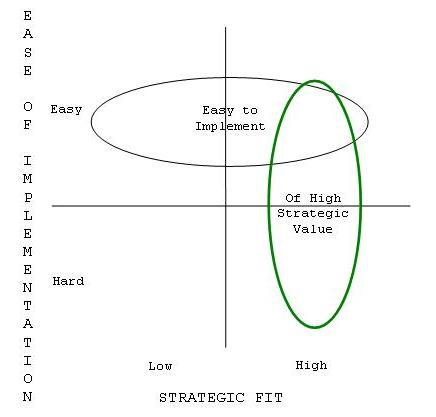Is your organization quick to pick the low hanging fruit? Do you gravitate first to the quick and easy? Are you prone to delay the bigger projects until you get those little ones out of the way?
Low hanging fruit is, by definition, quick and easy to implement, thus the lure to pick it is compelling. And picking the first piece usually exposes another, leading to an infinite quantity of low hanging temptations. While some of these quick fixes make excellent investments, many do not, and the nearly infinite supply can become a black hole for your limited resources.
Not only are the quick and easily-visualized fixes compelling, but the more important, strategic opportunities are often exactly the opposite because they can involve fundamental changes in how things are done. The most important initiatives will create an organization with new capabilities, new capacity, and new potential. These often require disruption to people, processes, resources, policies and/or technology. The complexity and level of departure from the norm can make both the goal and the path harder to visualize. The need for analysis and tough decisions ensures that many important opportunities will never be mistaken for low hanging fruit.
Here are some examples of low hanging temptations:
“Let’s get this system working right first”
- Improving the ease, speed or accuracy of data entry for data that is unused or ineffective in improving results
- Increasing cycle count accuracy for inventory that should be disposed of
“First, let me catch up on my email”
- Reading, sorting and responding to email that does not contribute to the goals of the company
“I just need to get organized”
- Reorganizing files, electronic or paper, that are rarely, if ever, used
- Updating schedules and plans that are mostly fiction
“I know I can buy these parts for less somewhere else.”
- Finding a cheaper supplier for a part that may be unneeded with strategic product positioning
“While we are at it…”
- Adding that extra software feature while making needed changes
- Fixing format inconsistencies in records before archiving them
One glance at the diagram below accentuates the dangers of pursuing low hanging fruit. You can readily see that success likely depends on a combination of easy and difficult tasks. You can also see that if your efforts are driven first by ease of implementation, you will squander resources on low hanging, unimportant fruit.
Are Your Resource Decisions Driven by Low Hanging Temptations?
You can’t avoid inappropriate low hanging temptations unless your employees are clear about the strategic objectives. Employees make decisions all day long that consume resources. If they do not know and understand the organization’s direction and priorities, they will pursue low hanging fruit. The only way to find out whether they are clear is for management to ask and listen.
Beyond that, you can listen for comments indicative of quick fixes, “We need to get a few things fixed and out of the way before we can start a bigger project.” Strategic initiatives are rarely described as “getting things out of the way.”
If you want to avoid the temptation of low hanging fruit, the following are critical:
- Have a clear strategy — A clear strategy, well-communicated, with realistic expectations and only a few top priorities for any one individual makes it easier for everyone to focus on the right things.
- Assess each idea for strategic fit — Insist that alternatives are weighed against strategic goals first. Ease must come second. There is nothing wrong with choosing an easy path as long as the strategic benefits are strong. Resist the temptation to invest in easy initiatives of medium strategic value over harder initiatives of high strategic value.
- Remain vigilant — It is so tempting to tackle the quick and easy but ‘tiny’ tasks multiplied by infinity is a mighty big number!
Without strong vision, strategy and discipline, the low hanging fruit will keep you busy for a long, long time, leaving strategic issues to languish. Accelerate progress toward your vision by pursuing the strategic over the easy.



Comments are closed.